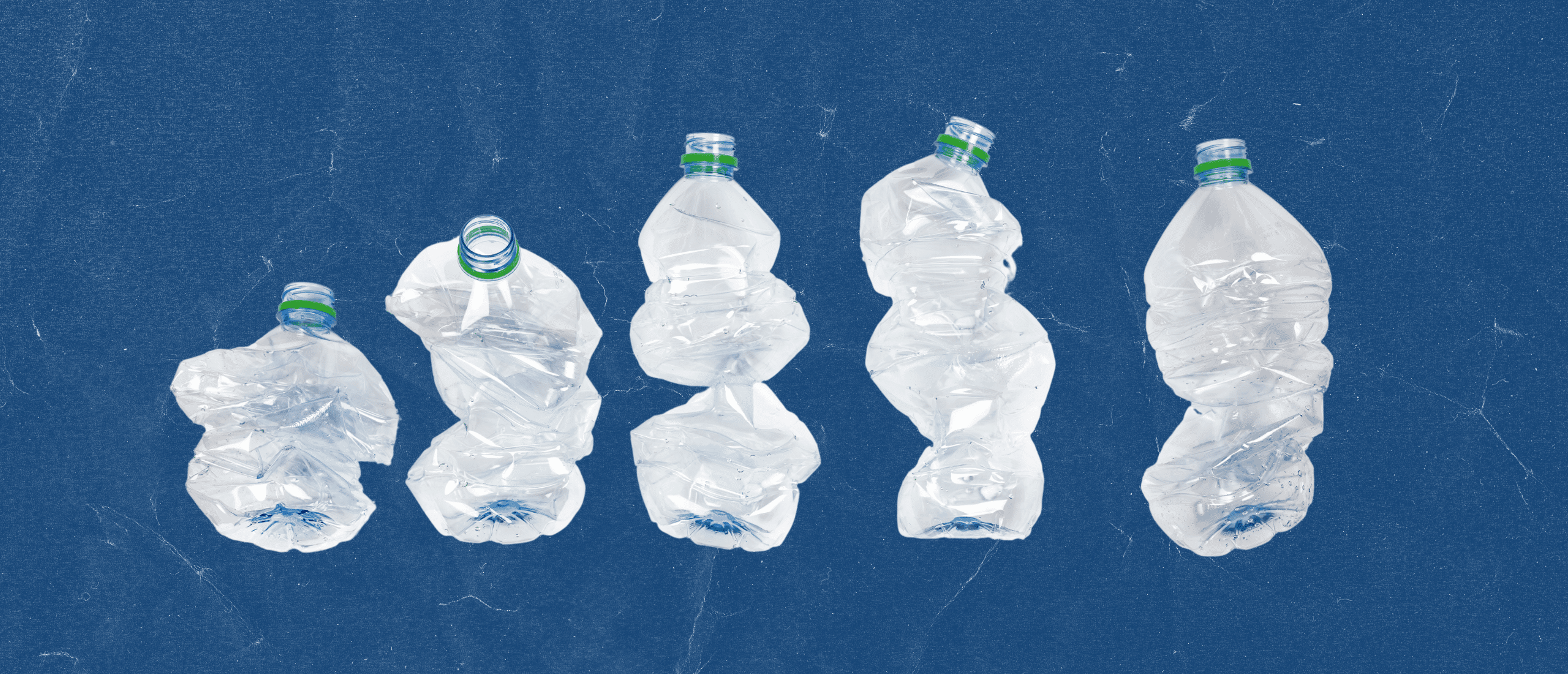Microplastics Are Screwing With Your Sperm. Here’s What to Do About It
- By Rebekah Harding
- January 10, 2024
- Fact-checked by Joy Ferguson
Fish aren’t the only swimmers that are suffering from microplastic exposure. These small plastic particles shed by larger plastic items in your home and environment may also impact male fertility and declining sperm quality in men, according to a 2022 review in the American Journal of Men’s Health(1).
Plastic is used to make everyday products like water bottles, Tupperware containers, personal care product packaging, plastic bags, and even clothing.
Microplastics result when plastic is broken down, for example by sunlight, water, and wind. Measuring less than 5 millimeters in length, some are small enough to go undetected by the naked eye.
The Impact of Plastics on Human Health
When this plastic pollution inevitably seeps into the food chain and water supply, it may lead to damaging health effects. Microplastic exposure may potentially affect or even damage your DNA, gut microbiome, and hormones (2, 3, 4)
In fact, research shows that the average adult unknowingly consumes about a credit card’s worth of plastic waste per week, depending on factors such as diet and where you live (5).
Research on the health effects of microplastics on human sexual health is still limited, but studies on mice have suggested a link between chronic microplastic exposure and reduced testosterone levels and male sexual dysfunction (6).
The effects of microplastic exposure is still being researched. But “if it has a similar effect on human males as it does on mice, it could potentially lower testosterone levels and induce sexual dysfunction,” says Anastasia Jandes, M.D., PharmD, IFMCP, who specializes in male hormone health.
How to Avoid Microplastics
Completely eliminating microplastics from your daily life is next to impossible, but these 10 easy tips can help you reduce the amount of potentially dangerous plastic pollution you accidentally consume.
Use an at-home water filter
It might be tempting to go straight for the tap after a long run, but you’ll want to filter your water before chugging down all those microplastics floating around the water supply.
A 2017 study that examined 159 samples of tap water from 8 countries found more than 83% of the samples were contaminated with microplastic particles (7).
That’s why filtration is your friend. Reverse osmosis filters (such as Brita and Pur) are the most effective way to remove plastic waste from your H2O at home. These work by pushing water through a semipermeable membrane that can catch small particles up to 0.001 microns—yup, that includes microplastics.
Toss your single-use plastic water bottle
Ever left a single-use plastic bottle in your car on a hot day, then took a swig? You probably got a little bit more than just pure H2O down the hatch.
When plastic is heated, it triggers some of the materials in the bottle to break down, which can release chemicals and tiny plastic particles into the liquid (8).
Even straight out of the fridge, drinking from single-use bottles isn’t totally safe. One study that tested water bottles across 11 global brands found that 93 percent of them contained some sign of microplastic contamination (9).
Plus, new research indicates that bottled water may have 100 times more plastic particles than previously thought. A 2024 study published in the Proceedings of the National Academy of Sciences found that each liter of brand-name water contained between 110,000 to 370,000 nanoparticles (24). (Although, researchers did not release which brands.)
Prior studies only accounted for microplastics, which are plastic particles between 1 and 5,000 micrometers long. Nanoparticles are below 1 micrometer long.
Your body and the environment will thank you for switching to a reusable, BPA-free water bottle.
Best BPA-Free Water Bottles
Be careful what you microwave
The microwave is one of the conveniences of modern living. But heating up your food in the wrong container may add microplastics to your dinner’s nutrition facts (just like leaving your plastic water bottle in the car).
Common chemicals found in plastics, like BPA (which may potentially block the normal effects of testosterone, lower sperm count, and hamper sperm production) and phthalates (which may inhibit testosterone production and cause sperm DNA damage) leech more easily when heated. (10, 11, 12, 13, 14).
To avoid the leaching of chemicals into your grub, transfer your food from its plastic container into a ceramic or glass container before you heat it up.
Meal prep
It’s easy to fall into the habit of bringing ready-to-eat freezer meals to work, but potentially exposing yourself to the chemicals from those single-use plastic containers isn’t worth the convenience.
Instead, try meal prepping (bonus points for using whole ingredients) before your busy work week starts so you don’t have to rely on microwave meals in between meetings.
Limit seafood
You’ve seen the disturbing photos of the “trash island” floating around the Pacific. Unfortunately, your favorite seafood has, too—and thought it was delicious.
Unfortunately, your favorite seafood may have been nibbling on this plastic debris in its habitat—and thought it was delicious.
“Microplastics can be ingested by animals that are later consumed by humans,” Jandes explains. And that’s incredibly common in marine ecosystems. Fish can munch on the plastic directly, or they may feed on zooplankton and other marine organisms that ingest the plastic waste.
Microplastics were detected in 75% of ten southern New Zealand commercial fish species tested, according to a study published in 2022 (15). Both bottom dwellers (like red cod) and surface-dwelling fish species (such as sardines) were affected. It’s not just wild marine ecosystems that are impacted, either: One study also suggests that farm-raised fish may ingest microplastics through processed fishmeal (16).
There’s more bad news for shellfish lovers. Another study suggested that people in countries with high shellfish consumption consumed up to 11,000 microplastic particles, each ranging from 0.005 to 1 millimeter in size from their meals alone each year (17).
That’ll make you think twice before ordering your favorite mussels or oysters next time you’re out.
Limit processed snacks
Microplastics in a sample of human feces shared “chemical similarity” with those in processed foods, reported a study published in 2022 (18). Researchers wrote that this “suggests that the risk of microplastic exposure from processed food consumption cannot be neglected.” The study suggested that processed foods may be contaminated with microplastics during production and packaging.
“Microplastics can enter the food supply through the food production process, for example, through the use of plastic equipment or packaging during the manufacturing, processing, or transportation of food,” says Jandes.
Reach for low or non-processed snacks like raw vegetables with hummus, nuts, or sun-dried fruit next time you get mid-day hunger pangs.
Clean up your bathroom
Planning to hop in the shower to scrub away all the microplastics you’ve touched throughout your day? Think again. Many shower products contain potentially dangerous concentrations of plastic polymers according to the United Nations Environment Programme.
To find out if your product contains microplastics, scan it with the ‘Beat the Microbead’ app, or look for the following commonly used plastic ingredients on the label: polyethylene (PE), polymethyl methacrylate (PMMA), nylon, polyethylene terephthalate (PET) and polypropylene (PP).
To cut down on plastic or help cut it out of your shower routine completely, opt for plastic-free packaging and ingredients, natural shampoos, and body washes. And don’t even think about touching the plastic loofah. Opt for a 100 percent cotton washcloth or natural loofah instead.
To cut plastic out of your shower routine completely, opt for packaging-free, natural shampoos and body wash. And don’t even think about touching the plastic loofah. Opt for a 100 percent cotton washcloth or natural loofah instead.
Install a laundry filter
Research suggests synthetic textile fibers like nylon, polyester, and acrylic are at fault for up to 35 percent of the microplastic pollution in the oceans (19)—and many of these fibers are released into the water supply during your weekly laundry cycle.
The toxic chemicals in your laundry detergent and the aggressive spin cycle can stress the synthetic fibers in your clothing, which causes them to shed small microplastic fibers that are small and malleable enough to slip past most filters (20).
Products like laundry filters and balls work to capture these fibers before they even get a chance to leave your washer. If you want to avoid a big installation project, some filters—like the Cora Ball— work as easily as tossing them in with your next load.
Put down the salt shaker
Sea salt boasts some great benefits like promoting hydration, balancing electrolytes, and regulating blood pressure. But microplastics from the ocean have also seeped into this staple ingredient.
One study found that a whopping 90 percent of sea salts contain microplastics (21).
Switching to Himalayan or Redmond sea salt may be the key to preventing microplastic exposure when you’re seasoning your dinner, according to biohacking expert Dave Asprey. These salts are sourced from mostly unpolluted sea beds that haven’t yet been contaminated with microplastics…for now.
Switch to loose tea leaves
Switching out your morning brew for an inflammation-soothing cup of green tea? You might want to reconsider. Just one tea bag can release 11.6 billion plastic micro and nanoparticles into your cup of tea—which is thousands of times more than previous estimates that humans consume between 39,000 to 52,000 particles a year (22)—according to a study by McGill University (23).
You don’t have to give up on tea entirely, though. Instead, opt for loose-leaf tea, which can be steeped in a reusable metal tea strainer—better for the planet, and your sperm.
References
1. Zhang, et al (2022). Microplastics May Be a Significant Cause of Male Infertility.
2. Hu X, et al (2021). Mutational signatures associated with exposure to carcinogenic microplastic compounds bisphenol A and styrene oxide. Gruber, et al (2022). To Waste or Not to Waste: Questioning Potential Health Risks of Micro- and Nanoplastics with a Focus on Their Ingestion and Potential Carcinogenicity.
3. Tamargo, A., et al. (2022) PET microplastics affect human gut microbiota communities during simulated gastrointestinal digestion, first evidence of plausible polymer biodegradation during human digestion
4. Ullah, S., et al (2023). A review of the endocrine disrupting effects of micro and nano plastic and their associated chemicals in mammals.
5. Jin, et al (2022). Chronic exposure to polystyrene microplastics induced male reproductive toxicity and decreased testosterone levels via the LH-mediated LHR/cAMP/PKA/StAR pathway.
6. Kosuth, et al (2017). Synthetic Polymer Contamination in Global Drinking Water.
7. Liu, et al (2022). Disposable plastic materials release microplastics and harmful substances in hot water.
8. Mason, et al (2018). Synthetic Polymer Contamination in Bottled Water.
9. Barboza, et al (2018). Marine microplastic debris: An emerging issue for food security, food safety and human health.
10. Bonefeld-Jørgensen EC, et al (2007). Endocrine-disrupting potential of bisphenol A, bisphenol A dimethacrylate, 4-n-nonylphenol, and 4-n-octylphenol in vitro: new data and a brief review.
11. Cariati F, Det al (2019). Bisphenol a: an emerging threat to male fertility
12. Gray LE, Jr., et al. (2000). Perinatal exposure to the phthalates DEHP, BBP, and DINP, but not DEP, DMP or DOTP, alters sexual differentiation of the male rat.
13. Parks LG, et al. (2000). The plasticizer diethylhexyl phthalate induces malformations by decreasing fetal testosterone synthesis during sexual differentiation in the male rat.
14. Duty SM, et al. (2003). Phthalate exposure and human semen parameters.
15. Isabella K. Clere, et a; (2022) Quantification and characterization of microplastics in commercial fish from southern New Zealand
16. Hanachi, P., et al. (2019). Abundance and properties of microplastics found in commercial fish meal and cultured common carp (Cyprinus carpio)
17. Luís Gabriel et al (2018). Marine microplastic debris: An emerging issue for food security, food safety and human health
18. Lin, et al (2022). Potential risk of microplastics in processed foods: Preliminary risk assessment concerning polymer types, abundance, and human exposure of microplastics.
19. Boucher, et al (2017). Primary microplastics in the oceans.
20. Falco, et al (2019). The contribution of washing processes of synthetic clothes to microplastic pollution.
21. Kim, et al (2018). Global Pattern of Microplastics (MPs) in Commercial Food-Grade Salts: Sea Salt as an Indicator of Seawater MP Pollution.
22. Hernandez, et al (2019). Plastic Teabags Release Billions of Microparticles and Nanoparticles into Tea.
23. Cox, et al (2019). Human Consumption of Microplastics.
24. Qian, et al (20240. Rapid single-particle chemical imaging of nanoplastics by SRS microscopy.











